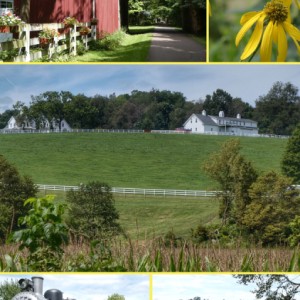Ariel Foundation Park
Sunday
Another morning/early afternoon of cycling today - this time the Kokosing Gap trail, which we have ridden before, but not for a number of years. Once the corridor of the Pennsylvania Railroad, the rail-trail now connects the towns of Mount Vernon, Gambier, Howard, and Danville, each just a few short miles apart. The trail passes through pleasant farmland, crosses the Kokosing River twice along railroad bridges more than 250 feet long, and passes through the short Howard Tunnel, adjacent to a big red former mill. In Gambier, the trail passes a beautifully restored locomotive and caboose, and at this point is also running along the edge of Kenyon college. It’s sport facilities - a huge sports centre and tennis courts - are to be found here, while most of the college is up on top of the hill,so we didn’t bother taking that on today, especially since it was move - in weekend for the students, but it is a beautiful campus and lovely small town - I have put a collage in the extras.
Having returned to Mount Vernon, we drove over to Ariel Foundation Park. The park is located on a former industrial site, the home of the Pittsburgh Plate Glass Company, which manufactured plate glass for automotive windshields. The plant was a sprawling complex of brick and steel girder buildings totaling 1,000,000 square ft., and was one of the largest plate glass companies in the world. In deciding to convert this site into a park for the enjoyment of the public, the Ariel-Foundation wanted to pay tribute to its industrial history and to the people of Mt. Vernon who worked there. It did so by artistically preserving elements from the site’s industrial past, for example preserving some of the ruins, and using some of the iron grid work and turning it into sculpture. The plant was closed by PPG in 1976, and the site then went through a series of owners, finally being acquired by the city of Mount Vernon in 2012. In 2013 ownership was transferred to the Ariel-Foundation which re-purposed the site as the unique park you see today. The former gravel pits that were on the site are now scenic lakes that are stocked with fish, and available for people to kayak. The dominant feature is the 280 foot smokestack which has been re-purposed as the Rastin Observation Tower pictured in the top left of my collage. A spiral stairway around the outside of the smokestack climbs 140 feet to an observation deck offering a great view of the park and the town of Mt Vernon. Below that is the River of glass, filled with chunks of glass called “cullet” and crushed glass. Down the right hand side is one of the gateways, the area known as the Terraces, the Tree of Life labyrinth and one of the ruined buildings, left as a heritage piece. Among the other industrial structures that have been preserved and re-purposed, but not shown in my collage, is the 17,000 Square foot Schnormeier Event Center. It is a 17,000 square foot building, used for special events such as films or concerts. The one thing I felt was missing was some boards with pictures of the old plant and some of the employees, and some in progress photographs. Otherwise, I though it was an excellent example of industrial renewal.


Comments
Sign in or get an account to comment.


